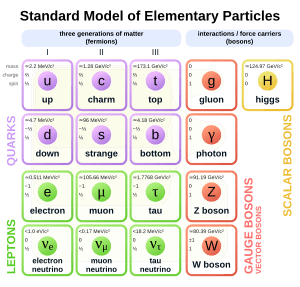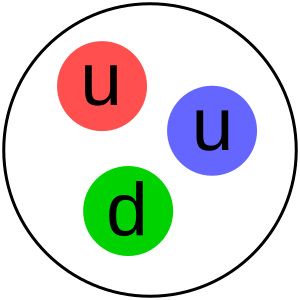Standard Model facts for kids
The Standard Model is a big idea in physics. It helps us understand the smallest pieces of everything around us. These tiny pieces are called elementary particles. The model also explains three of the four main forces in nature. These forces are electromagnetism, the weak force, and the strong force. The Standard Model does not explain gravity.
This model uses ideas from quantum mechanics (how tiny things behave) and special relativity (how things move very fast). It also talks about physical fields and how symmetry can be broken.
Contents
What are Fermions?
Fermions are the particles that make up all the "stuff" we see. Things like protons and neutrons are made of fermions. Fermions have features you can see, like charge and mass. They also have other features, like spin and "color charge," which you can't usually see. These features are given special numbers called quantum numbers.
Fermions have a special kind of spin. Their spin numbers are always like 1/2, 3/2, or 5/2. We say they have "half integer spin."
A very important rule for fermions is the Pauli exclusion principle. This rule says that no two fermions can be in the exact same "spot" at the same time. It means no two fermions in an atom can have all the same quantum numbers. The word "fermion" comes from the scientist Enrico Fermi.
There are 12 different types of fermions. Each type is called a "flavor." They are:
- Quarks — There are six types: up, down, strange, charm, top, and bottom.
- Leptons — There are six types: electron, muon, tau, electron neutrino, muon neutrino, and tau neutrino. The electron is the most well-known lepton.
Quarks come in three pairs, called "generations." The first quark in each pair has a charge of 2/3. The second quark in each pair has a charge of -1/3. Neutrinos have no charge (0). Electrons, muons, and taus have a charge of -1.
Matter is made of atoms. Atoms are made of electrons, protons, and neutrons. Protons and neutrons are made of up and down quarks. You can find a lepton, like an electron, by itself. But you can never find quarks alone. This is because quarks are held tightly together by the color force.
What are Bosons?
Bosons are the second type of elementary particle in the Standard Model. All bosons have a whole number spin (like 1, 2, or 3). This means many bosons can be in the same place at the same time. There are two main types of elementary bosons: gauge bosons and the Higgs boson.
Gauge bosons are what make the fundamental forces of nature happen. When a force acts on fermions, it's because gauge bosons are moving between them, carrying the force. The word "boson" honors the Indian physicist Satyendra Nath Bose.
The Standard Model says there are:
- 12 fermions, and each has its own anti-particle.
- 12 gauge bosons: 8 types of gluons, the photon, W+, W−, and Z bosons.
Scientists have seen all these particles in nature or in experiments. The model also predicted the Higgs boson. The Higgs boson is thought to give other particles their mass. It was believed to be discovered on July 4th, 2012.
The Basic Forces
There are four basic forces known in nature. The Standard Model explains three of them. These three forces affect fermions and are carried by bosons.
- Strong force: This force holds quarks together to make particles like protons and neutrons. Gluons carry the strong force. The study of quarks, the strong force, and gluons is called quantum chromodynamics (QCD).
- Weak force: This force can change one type of fermion into another. It causes things like beta decay. The weak force is carried by three gauge bosons: W+, W-, and the Z boson.
- Electromagnetic force: This force explains electricity, magnetism, and light. The photon carries this force. The study of electrons, photons, and electromagnetism is called quantum electrodynamics (QED).
The fourth force affects all particles, but the Standard Model does not explain it.
- Gravity: This is the only basic force not explained by the Standard Model. Scientists think it might be carried by a particle called the graviton. But they have not found the graviton yet.
The strong and weak forces only work inside the tiny nucleus of an atom. They work over very short distances, about as wide as a proton. The electromagnetic force and gravity work over any distance. But their strength gets weaker as objects move farther apart. If two objects are twice as far apart, the force between them becomes four times weaker.
What the Standard Model Doesn't Explain
The Standard Model is very good, but it doesn't explain everything.
- It does not include a full theory of gravitation, which is explained by general relativity.
- It doesn't explain why the universe is expanding faster and faster. This might be due to something called dark energy.
- The model does not include a particle for dark matter. Dark matter is a mysterious substance that scientists think makes up a lot of the universe.
Even with these things it doesn't explain, the Standard Model works very well. It has been successful in predicting what scientists find in experiments.
See also
 In Spanish: Modelo estándar de la física de partículas para niños
In Spanish: Modelo estándar de la física de partículas para niños



